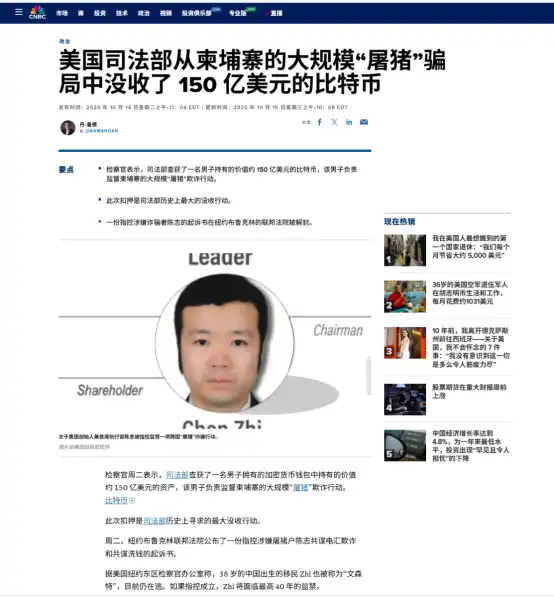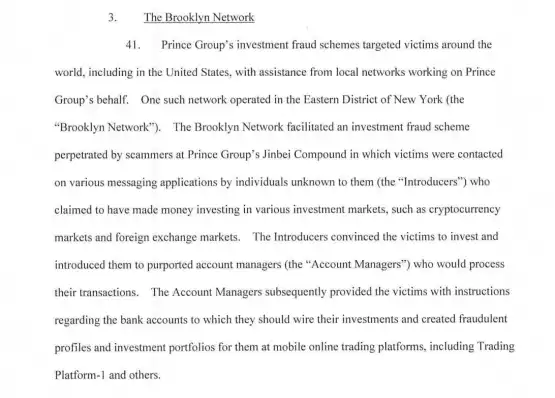120,000 Bitcoins intercepted? In-depth analysis of the regulatory challenges behind the "Prince Group" case
Original Title: "Case Study | 120,000 Bitcoins Seized? Web3 Lawyer Deeply Analyzes the Regulatory Dilemma Behind the 'Prince Group' Case"
Original Source: Crypto Salad
Introduction
As global crypto asset regulation tightens, a cross-border "on-chain pursuit" spanning Cambodia, the US, and the UK has captured everyone's attention. In October 2025, the US Department of the Treasury and Department of Justice launched the largest crypto financial enforcement action in history against Cambodia's Prince Group, freezing as many as 120,000 bitcoins.

(Image above from US CNBC channel)
This case has shaken not only the blockchain industry but also our traditional understanding of "financial sovereignty": When digital assets cross borders and flow anonymously, how can sovereign states technically track, legally sanction, and regain the initiative in enforcement? When the US can extend its enforcement reach through financial networks, how can we establish our own systems for digital asset recovery and judicial disposal?
This article will analyze the legal logic and international regulatory dilemmas behind the "Prince Group" case from four perspectives: case review, judicial basis, technical vulnerabilities, and regulatory insights. It also attempts to answer an increasingly urgent question—who truly holds enforcement sovereignty in the era of digital finance?
I. Case Review
First, let's try to reconstruct the specific facts of the Prince Group case to analyze its significance.
In October 2025, the US Department of the Treasury (OFAC) launched one of the largest single judicial strikes in history against the "Prince Group transnational criminal organization," sanctioning 146 members. Subsequently, the US Department of Justice (DOJ) announced indictments: accusing Chen Zhi of organizing and operating a "pig butchering" crypto investment scam based on forced labor camps, as well as conspiracy to commit telecom fraud and money laundering. Surprisingly, the DOJ claimed to have seized more than 127,000 bitcoins.

(Image above from the US Department of Justice website)
How were these bitcoins actually scammed? In fact, it's quite simple. According to the indictment, Chen Zhi led the Prince Group in conducting large-scale online investment scams, luring victims to invest in USD or cryptocurrencies. The platform would display account balances or show profits growing, but in reality, the funds had already been transferred out and pooled into wallets controlled by Chen Zhi. At the same time, the Prince Group invested in or rented real mining farms through companies like LuBian Mining and purchased computing power from the open market, making outsiders believe they were mining bitcoin and giving the appearance of "legitimate generation."
For such a massive crypto scam, there are reports that China set up a special task force in Beijing five years ago to investigate the case. However, perhaps due to the passage of time, we could not find any official information or news, only media paraphrasing, so the authenticity cannot be easily confirmed. But how did the US and UK manage to control such a large amount of bitcoin at once, and how did they extend their enforcement reach to Cambodia in the distant East?
1. Source of US Jurisdiction
The indictment clearly states that the Prince Group's scam network included global victims, including those in the US, with a local network operating in Brooklyn, New York. Victims were lured to transfer funds into shell company accounts in Brooklyn and Queens, which were then transferred internationally or via virtual currencies back to accounts controlled by the Prince Group and Chen Zhi. In other words, these accounts were opened at US financial institutions and cleared through US financial institutions. According to the US Constitution, as long as any part of the criminal conduct occurs in the US or produces consequences there, territorial jurisdiction is established. The indictment also explicitly states that, because the conduct and consequences occurred in this district, the case falls under the jurisdiction of the Eastern District Court of New York.

(Image above from the original indictment)
2. Why Was Execution So Smooth?
On the criminal side, US judicial authorities issued seizure orders for 127,271 bitcoins and other criminal proceeds controlled by Chen Zhi under the Criminal Asset Forfeiture Act (18 U.S.C. §§ 981, 982). On the financial sanctions side, the US Treasury, under Section 311 of the Patriot Act (31 U.S.C. § 5318A), designated the Prince Group and its associated financial network as a "Primary Money Laundering Concern," enabling immediate freezing of accounts and transactions related to the US financial system. Combined with the Global Magnitsky Human Rights Accountability Act (22 U.S.C. § 2656), the US can impose global asset freezes and transaction bans on foreign individuals involved in serious human rights abuses or major corruption.
In addition, with Federal Rule of Criminal Procedure 41 and the Mutual Legal Assistance Treaty (MLAT) mechanism, the US can smoothly execute seizure, pursuit, and asset disposal measures through blockchain custody nodes, exchanges, and multilateral cooperation.
3. Technical Vulnerability Suspicions
Why was the US able to easily freeze the bitcoins? Besides the powerful on-chain team behind the US, Crypto Salad also heard an interesting theory from a well-known blockchain forensics and compliance technology firm, Elliptic Blog, which is worth sharing with readers:
At the end of 2020, a mining company called LuBian Mining (yes, the one mentioned earlier) suffered a serious security incident. In short, the random number vulnerability (also known as "Milk Sad") in the algorithm generating the private keys for the bitcoin vault allowed attackers to crack the private keys and transfer out all the bitcoins in the mining pool—reportedly, exactly 127,000 bitcoins. Until June-July 2024, this batch of bitcoins showed new activity, and the wallets involved overlapped or merged with those of the Prince Group network and wallets controlled by Chen Zhi. Ultimately, in 2025, the US Department of Justice officially seized them.
Undoubtedly, among the 120,000 bitcoins frozen from the Prince Group, a considerable portion originated from funds "contributed" by the Chinese community. However, under the current legal and technical landscape, it is almost impossible for us to recover our rightful interests. Regardless of whether the state has launched an investigation or taken action, the "Prince Group" case serves as a wake-up call: In the digital finance era, financial sovereignty is not only reflected in currency issuance but also in the effective exercise of enforcement sovereignty. When transnational crimes are exposed, we must have clear legal grounds, mature technical systems, and resolute enforcement capabilities to truly safeguard and recover assets that rightfully belong to us.
II. Conclusion
The "Prince Group" case is not the first, nor will it be the last of its kind. It profoundly reminds us that while initial regulatory policies may achieve their intended goals, they may also cause us to lose some initiative in the new round of global financial competition.
Faced with the inevitable trend of digital assets, we must find a new balance between "strict risk control" and "sovereignty." Establishing an independent and controllable digital asset judicial disposal system to ensure that our country's legal dignity and enforcement capabilities extend into the digital space is an urgent issue. Only in this way can we truly achieve "asset recovery according to law" in the future—whether by confiscating assets to enrich the national treasury or by proportionally liquidating and returning them to victims—thus completing the final enforcement loop and effectively protecting the property safety of the people.
This article is a submission and does not represent the views of BlockBeats.